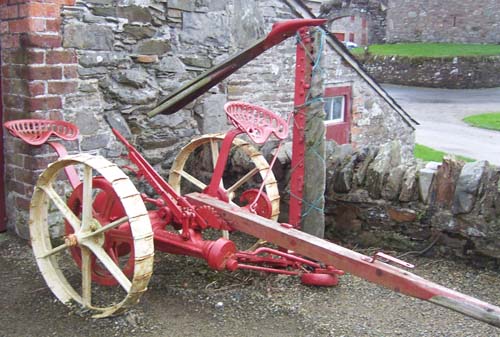|
|
|
| |
Horse
Reaper. |
||||
Timelines of Cyrus McCormick's Reaper 1824 At the age of 15, he invented a lightweight cradle for carting
harvested grain Visit the McCormick web site The cutting bar, standing upright in the illustration is lowered to the ground when in use. it was usually five ft long, consisting of steel fingers spaced at about four inch spacing, between these was the knife blade this consisted of a strip of steel onto which triangular blades were riveted. The knife bar reciprocated back and forth, driven by a crank which received its power from the cast iron land wheel via a step up gearing. As the cutting bar moved through the crop the blades cut the stalks as they came between the fingers. The cut stalks then fell behind the cutting bar,
most of these machines had two seats, the rear one for the driver who
controlled the horses and a lever which altered the the angle of attack
of the cutting bar. The passenger sat on the seat on the right he had
a long wooden rake like tool which he used to gather the crop in in
sheaf sized bundles, this saved those following behind who's job it
was to tie the sheaves having To tie the sheaves the worker lifted the bundle and took a handful of the stalks and wrapped them round the waist of the sheaf, the ends of the stalks were twisted round each other about three times and the ends then tucked beneath the belt from the top. He moved on to the next sheaf while someone came behind him gathering four sheaves and propping them against each other to form a stook, this enabled the crop to dry in the wind and sun. The paragraph above applies to grain crops such as corn wheat and barley, hay was allowed to fall behind the reaper and left for a time to dry, before being turned with pitch forks several times before being gathered and built into bart's (Rounded conical heaps) See hay rake. While the reaper was revolutionary in its time its successor was to be even more so, the binder which was basically a reaper with added attachments not only cut the crop but tied it into sheaves with twine.
In this video the binder is pulled by a tractor, many horse binders were converted to be pulled by tractors. |
||||
|
|

 below is a horse reaper this machine was drawn by two horses,
in its time it was at the cutting edge of agricultural technology,
prior to its introduction in the mid 1800's hay or grain crops
were cut with the sickle and scythe.
below is a horse reaper this machine was drawn by two horses,
in its time it was at the cutting edge of agricultural technology,
prior to its introduction in the mid 1800's hay or grain crops
were cut with the sickle and scythe. to
gather the crop into sheaves.
to
gather the crop into sheaves.